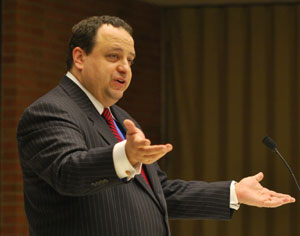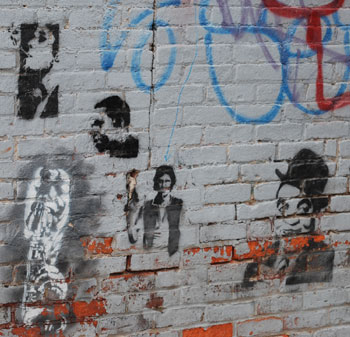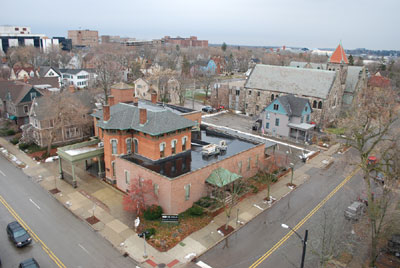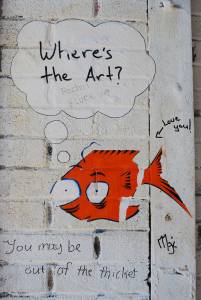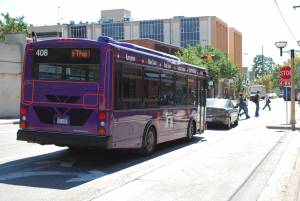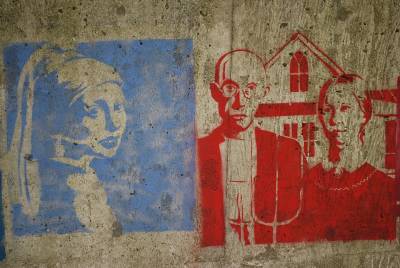Vandalism at the DKE house: blue spray paint on front door.
Stories indexed with the term ‘graffiti’
Washington & Main
Graffiti can be interpreted as (at least) two different animals. What do you see first? [photo] Bonus points for identifying the location more closely than the nearest intersection.
W. Liberty
Brick wall at Skin Bar being scrubbed clean of black graffiti with substance called “elephant snot.”
W. Washington & First
8 a.m. power washing of new black graffiti scrawl on old red brick building converted to offices.
Summit & Main
First Street
First Street parking lot wall reveals new colorful, carefully-designed graffiti of cartoon character(s) saying “I’m high.”
Parks Group Applauds “Status Quo” Budget
Ann Arbor park advisory commission meeting (April 16, 2013): After several years of cuts, the city’s parks system anticipates no significant budget changes in fiscal year 2014, which begins July 1, 2013.

Graffiti at Argo Pond. Parks and recreation manager Colin Smith reported that there’s been an increase in graffiti in the parks system. (Photos by the writer.)
Park commissioners were briefed on budget details at their April meeting, and voted unanimously to recommend the budget for approval. The parks budget will be a component of the overall budget that the city council will vote on in mid-May. The public hearing on that budget will be held on May 6. “The message is status quo,” parks and recreation manager Colin Smith told commissioners.
In a separate vote, commissioners recommended raising fees – ranging between 4-9% – for rentals at the Gallup Park meeting room and Cobblestone Farm. It was the first fee increase at these facilities since 2007 and 2006, respectively.
In other action, commissioners unanimously recommended approval of a five-year contract with Coca-Cola Refreshments for cold beverage concessions. It will replace the 10-year contract with Pepsi that expires this summer. Pepsi was the only other bid received by the city for a new contract, but missed the deadline and was disqualified.
Commissioners also recommended that the city award a $535,000 contract to Pranam Global Tech Inc. to replace the nearly 40-year-old roof at Veterans Memorial Park Ice Arena. The project includes a 10% construction contingency of $53,500, bringing the total project budget to $588,500.
Public commentary included an update from advocates of an ice-skating rink at the city-owned Library Lane site, as well as a report from the Library Green Conservancy, which hopes to make the parking lot into a park. [.pdf of Library Green Conservancy report]
Updates from commissioners included ongoing efforts to find a new centrally located dog park, as well as more information-gathering work by the downtown parks subcommittee.
And in his manager’s report, Smith informed commissioners of an increase in spray-painted graffiti in the parks. The staff is collecting data on how much time they spend repairing areas that are hit with graffiti, “and it’s substantial,” he said. Even trees have been tagged, which is unusual, Smith reported. “There have been some rather inappropriate things painted on some very nice trees.” He added: “It’s extremely frustrating … We’re not in the business of providing spray-painting opportunities any more than we are in the business of providing apothecary options for people in the parks. I’ll leave it at that.” [Full Story]
Fourth Ave. & Washington
Bob Margraves is on a ladder painting over graffiti in the alley next to the Blue Tractor. Says he’ll be heading down to work on the Grizzly Peak building next, which also got hit. Takes me on a mini-tour of the alley to show extensive graffiti, including this area on the Arena building. [photo] Business is good for him, but costly to owners of downtown buildings.
Washington & First
Downtown
Going across downtown area all the way to athletic campus while viewing “SAES” graffiti everywhere the whole way.
Council OKs Graffiti Law, Questions AATA Plans
City Council Meeting (Jan. 20, 2009): Ann Arbor city council gave final approval to the anti-graffiti ordinance on its agenda, though with some revisions that lighten its impact on property owners – compared to the version that was moved along in the process at its last meeting. And after long discussion of the somewhat complex fund transfers involved in funding the Farmers Market improvements project, council postponed the vote for two weeks.
But some of the more animated discussion came during the annual update provided by board chair of the Ann Arbor Transportation Authority, David Nacht, when councilmembers Stephen Rapundalo and Marcia Higgins pressed Nacht to explain the recently proposed fare increases and to clarify what the regionalization of the AATA might mean for Ann Arbor taxpayers. [Full Story]
Proposed Graffiti Ordinance Softened
Although the punishments for those who apply graffiti would remain intact, the impact of a proposed new anti-graffiti ordinance on property owners would be lessened under a revised version of the law. The original version of the proposed anti-graffiti ordinance was approved by council at its first reading at the Dec. 15 city council meeting, which advanced it along in the usual process to a public hearing and second reading, scheduled for council’s Jan. 20 meeting.
Since that December meeting, sponsors of the new ordinance (which include councilmembers Margie Teall, Carsten Hohnke, Leigh Greden, and Christopher Taylor) have met with various business owners, the Ann Arbor Area Chamber of Commerce, the Downtown Development Authority, and city staff, which resulted in changes to the proposed ordinance. [Full Story]
No Formal Study Committee for Germantown
Ann Arbor City Council (Dec. 15, 2008) City council heard extensive public commentary and suspended its own rules to allow for more deliberation on the topic of appointing a study committee for a new historic district possibly to be called Germantown. But in the end, the proposal garnered only one vote in addition to those of its two sponsors. In other business, council moved an anti-graffiti ordinance to a second reading (the next step for any amendment to the city code), and approved an intent to issue $9 million in bonds to fund the parking structure portion of Village Green’s City Apartments project. [Full Story]
Germantown: Study It or Not?
Ann Arbor City Council Caucus (Dec. 14, 2008) At its Sunday caucus, city council discussed two items on its agenda for Monday night:
- Historic District Study Committee – a resolution to appoint a study committee to determine the suitability of establishing a historic district called Germantown, which would include roughly the area bounded on the north by William Street, on the west by Fourth Avenue, on the south by Madison Street and on the east by Division Street.
- Graffiti Ordinance – a resolution to amend the city’s code to set forth punishments for graffiti, both for applying it and for allowing it to remain in place.
Discussion of the historic district study committee was driven by attendance at caucus of interested parties to the decision. Those parties included several residents of the neighborhood as well as a developer who has a project located inside the district of the proposed study. That project (City Place) is currently being considered by council.
Documenting the Urban Landscape
When a Chronicle reader saw our article on graffiti art, she shot us an email saying we should check out Janice Milhem’s work, too.
Milhem isn’t a graffiti artist, but she documents urban landscapes – in Detroit, Berlin, New York, Marrakech and Ann Arbor, among other locales – through photographs that reflect both the grit and gravitas of life on the streets.
You Say Graffiti, We Say…
The alley next to Michigan Theater transformed pretty quickly over the summer from a colorful, artistically-coherent mural to a colorful collage of random graffiti – prompting Mr. Limpet to ask, “Where’s the Art?”
In early July, someone painted a swath of white over part of the mural called “Infinite Possibilities,” which had been created there in 1999. The Ann Arbor News ran an article about the incident, interviewing the artist, Katherine Tombeau Cost, who now lives in New Orleans. She said it had taken her five months to complete, but she wasn’t ticked off by the graffiti: “The thing about public art it is an exercise in letting go. You put it out there and you know it is not forever. I have to remind myself this isn’t my family room. That is the element of public art. It will be great and it will be gone.”
And now it’s really gone. [Full Story]
MM Does The Link
I’ll admit – I’m not a regular rider of those purple buses that circle downtown Ann Arbor. In fact, this summer when I thought, “Hey – I’ll ride The Link!” I was revealed to be an idiot, unaware that the fleet went on haitus as soon as UM students dispersed. (Even though AATA posted signs to that effect at each stop. When you aren’t looking, you don’t see.)
Now, like the students, The Link is back. So when I set off for a chat with Ken Nisbet of UM’s Office of Technology Transfer, which sits above the Starbucks on South University, I decided to grab a free ride. [Full Story]
You Say Graffiti, We Say Stencil Art
We’ve all seen the ubiquitous stencil art around town – often, but not always, making some pointed political or social commentary.
But you’ll prove you really know the city if you can identify the locale of this work:




